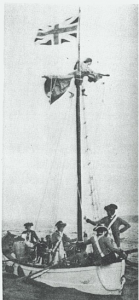The boat shown here under British colors will be flying the colors of the United States following its rechristening as the “Philadelphia” at ceremonies at the Skenesborough Museum grounds launching site on the afternoon of the Fourth of July. The ceremony will take place following the religious service in which the ecumenical churches of Whitehall will participate.
This 28-foot boat is a converted lifeboat, outfitted for sailing and also fitted for rowing. There are eight oarsman stations. A crew of ten seamen and officers will be the normal complement. The craft will be armed with cannon and various other arms.
A second boat which will be christened the “New York” will be put in service, at a later date, coinciding with the completion date anniversary of the last of Arnold’s fleet built in 1776 Skenesborough.
The future “New York” of slightly different construction, it will be on the Skenesborough grounds during next week’s festival and for some time thereafter to be repaired and outfitted in preparation for its joining the “Philadelphia” as a second ship the Skenesborough Navy.
The Celebration ‘76 Bicentennial commission has purchased the boats, which now will become property of the Skenesborough Museum and will be used to acquaint youth with the naval heritage of Skenesborough (Whitehall).
Volunteers of all ages are invited to become members of the ‘Skenesborough Navy” and to participate in reenactments and sailing exercises.
An invitation has already been received for Sept. 17, 1977, a year in advance for the boats to take part in the battle of Diamond Island near Lake George.
During the summer of 1977, the boats will be active in the Burgoyne Invasion and will be involved in the battle of Skenesborough harbor.
Individuals and organizations wishing to assist financially the support of this new venture in the teaching of Skenesborough’s history should contact either the Bicentennial commission or the Skenesborough Museum.
Doris B. Morton, Town Historian – The Whitehall Times – July 1, 1976
